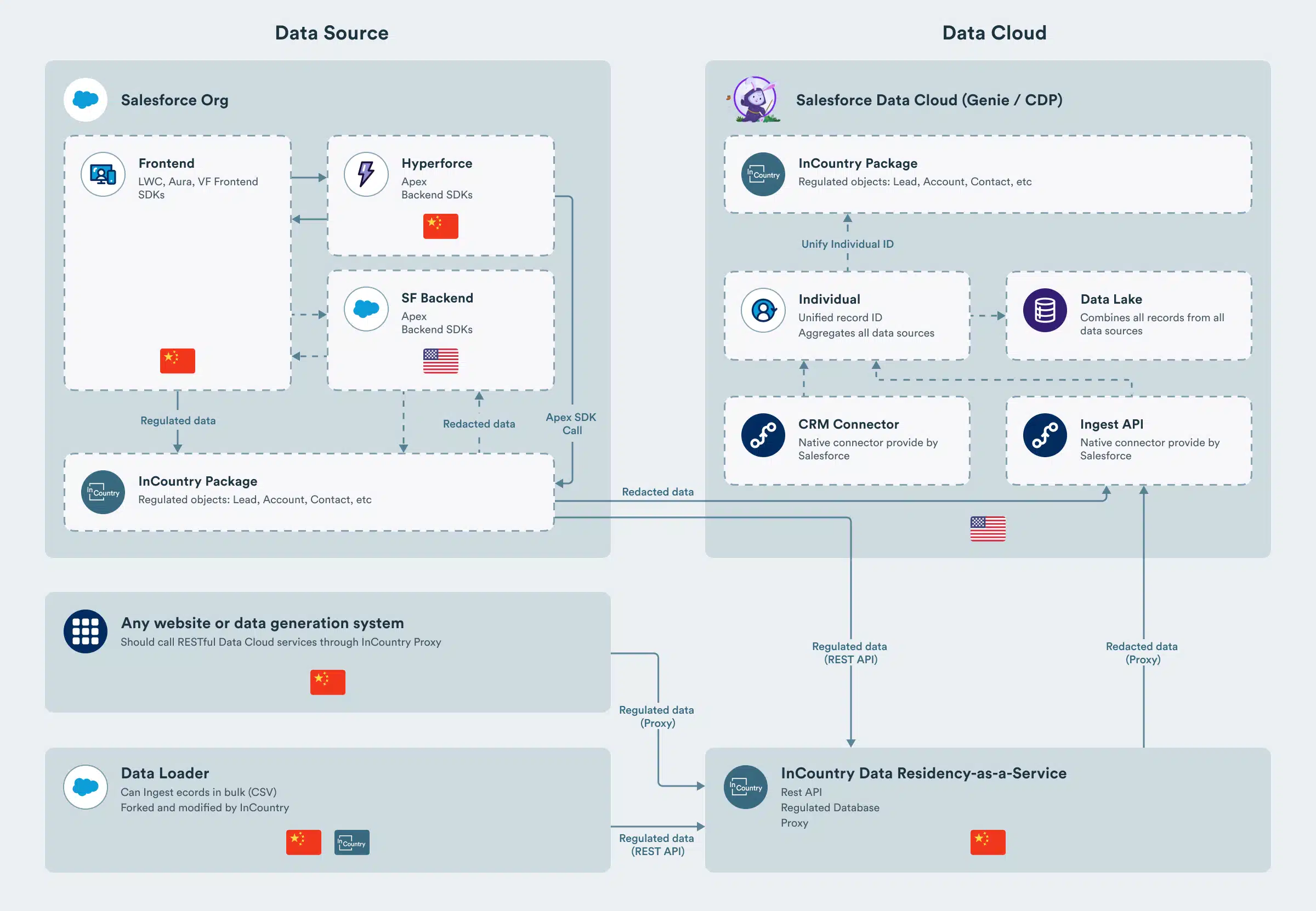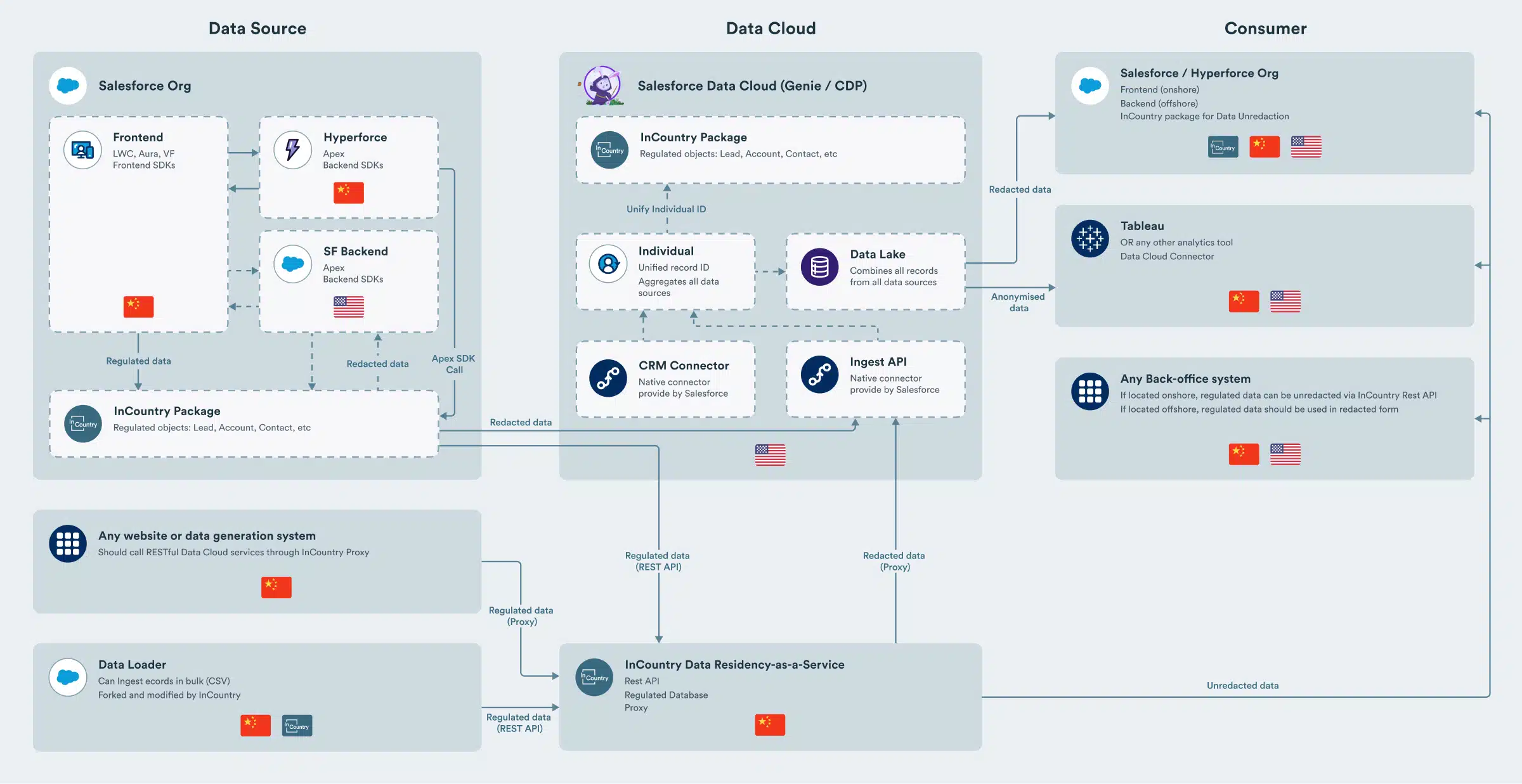InCountry’s integration with Salesforce Data Cloud adds data residency for global customer views and AI
At the Dreamforce 2023 conference today, we are excited to announce InCountry’s end-to-end integration with Salesforce Data Cloud, Salesforce’s solution to harmonize customer data from a variety of data sources in real-time. It’s exciting to collect all customer information in a single global data store, however cross-border data regulations and data residency laws make it more and more challenging to create a single global view.
Ingesting local data while anonymizing the global view
InCountry’s Data Residency-as-a-Service (DRaaS) is wire-compatible with web service data ingestion flows. It’s easy to route data originating from within a country to the InCountry Point-of-Presence in that country, automatically redact and store PII data, and pass on fully compliant data with PII anonymized by encryption, tokenization, or masking.
For importing data into the application, Salesforce Data Cloud provides the Ingestion API supporting the streaming and bulk modes. You can effortlessly stream data into Salesforce Data Cloud using two proprietary InCountry DRaaS components, InCountry for Salesforce and InCountry Border.
Let’s see a typical data flow that the InCountry for Salesforce package may implement. It all starts with a DML event, which might be an automatic process or a value modification through the user interface. The package captures regulated data and securely saves it to the InCountry Vault located in the country of origin. Regulated data is further anonymized using the best suitable technique like tokenization, hashing, or data masking to guarantee data privacy. The impersonated data is sequentially saved to the Salesforce database, and, finally, ingested into Data Cloud through the CRM Connector or the Ingestion API. Based on Salesforce record IDs, mappings between records in the InCountry Vault, Salesforce, and Data Cloud are created.
Let’s explore the flow utilizing the InCountry Border. The idea is quite similar, even though the procedure could vary slightly. Requests to create or edit records are intercepted by InCountry Border, which operates as an HTTP proxy server, once they are streamed into the Ingestion API. The regulated data is safely saved to the InCountry Vault after its anonymization. Border creates a record identifier during the pre-commit stage, which serves as the primary or composite key. Following that, the request is sent to the Data Cloud using the Ingestion API. The Salesforce record identifier is used for record mapping, so you can easily query regulated data for specific records from Data Cloud.
Consolidating data around a unique identifier
Salesforce Data Cloud has a mechanism to reconcile into a
single customer view by a Salesforce record ID. InCountry is fully compatible with this mechanism since data that is anonymized with deterministic tokens and other mechanisms can still be reconciled with existing views of the user or entity.

Using the local data within Salesforce
Once there is anonymized data in Salesforce Data Cloud, how will authorized users see the data? InCountry’s Salesforce Managed Package offers deep integrations with Salesforce forms, lists, reports, and other features so the Customer 360 data can be viewed by authorized users. InCountry’s data firewall ensures that users from outside the country can not see resident data, and InCountry’s integration with Salesforce’s fine-grained authorization policies ensures there is no data loss prevention. The solution is also compatible with Salesforce Marketing Cloud bulk emailing.
Data extraction from the Data Cloud may be retrieved programmatically using the Profile API, Query API v1 or v2, or a native connector. You can use a primary or composite key, or a filter by non-regulated values to query records. Once the record is fetched from Data Cloud, you can supplement it with regulated data grabbed from the InCountry Vault.
The complete global view for AI and more, with fully compliant local data
Combining Salesforce Data Cloud with InCountry offers the ability to have a global view of prospects and customers while still maintaining strict data privacy and residency controls. Salesforce’s new features such as AI can operate on the full customer data set without compromising data residency compliance.

Next steps with InCountry for Salesforce Data Cloud
Are you currently using the Data Cloud or considering a switch, but feeling uncertain about data residency challenges? No fear! Our expert sales team is here to guide you through the decision-making process. We understand your current use cases and are happy to address any potential limitations you may encounter. Reach out to us today and let us ensure you make the right choice for your needs!


